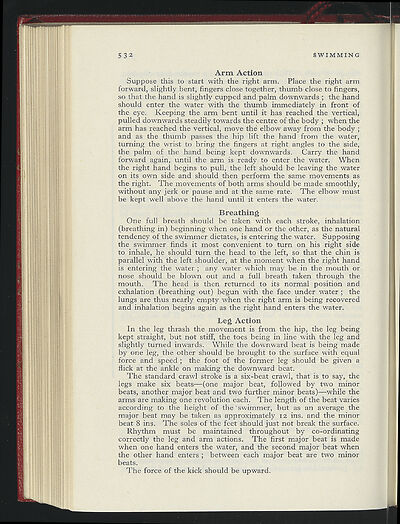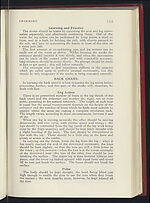1938-39
(562)
Download files
Complete book:
Individual page:
Thumbnail gallery: Grid view | List view

Ili
1§
53
2
SWIMMING
Arm Action
Suppose this to start with the right arm. Place the right arm
forward, slightly bent, fingers close together, thumb close to fingers,
so that the hand is slightly cupped and palm downwards ; the hand
should enter the water with the thumb immediately in front of
the eye. Keeping the arm bent until it has reached the vertical,
pulled downwards steadily towards the centre of the body ; when the
arm has reached the vertical, move the elbow away from the body ;
and as the thumb passes the hip lift the hand from the water,
turning the wrist to bring the fingers at right angles to the side,
the palm of the hand being kept downwards. Carry the hand
forward again, until the arm is ready to enter the water. When
the right hand begins to pull, the left should be leaving the water
on its own side and should then perform the same movements as
the right. The movements of both arms should be made smoothly,
without any jerk or pause and at the same rate. The elbow must
be kept well above the hand until it enters the water.
Breathing
One full breath should be taken with each stroke, inhalation
(breathing in) beginning when one hand or the other, as the natural
tendency of the swimmer dictates, is entering the water. Supposing
the swimmer finds it most convenient to turn on his right side
to inhale, he should turn the head to the left, so that the chin is
parallel with the left shoulder, at the moment when the right hand
is entering the water ; any water which may be in the mouth or
nose should be blown out and a full breath taken through the
mouth. The head is then returned to its normal position and
exhalation (breathing out) begun with the face under water ; the
lungs are thus nearly empty when the right arm is being recovered
and inhalation begins again as the right hand enters the water.
Leg Action
In the leg thrash the movement is from the hip, the leg being
kept straight, but not stiff, the toes being in line with the leg and
slightly turned inwards. While the downward beat is being made
by one leg, the other should be brought to the surface with equal
force and speed ; the foot of the former leg should be given a
flick at the ankle on making the downward beat.
The standard crawl stroke is a six-beat crawl, that is to say, the
legs make six beats—(one major beat, followed by two minor
beats, another major beat and two further minor beats)—while the
arms are making one revolution each. The length of the beat varies
according to the height of the
-
swimmer, but as an average the
major beat may be taken as approximately
12
ins. and the minor
beat 8 ins. The soles of the feet should just not break the surface.
Rhythm must be maintained throughout by co-ordinating
correctly the leg and arm actions. The first major beat is made
when one hand enters the water, and the second major beat when
the other hand enters ; between each major beat are two minor
beats.
The force of the kick should be upward.
1§
53
2
SWIMMING
Arm Action
Suppose this to start with the right arm. Place the right arm
forward, slightly bent, fingers close together, thumb close to fingers,
so that the hand is slightly cupped and palm downwards ; the hand
should enter the water with the thumb immediately in front of
the eye. Keeping the arm bent until it has reached the vertical,
pulled downwards steadily towards the centre of the body ; when the
arm has reached the vertical, move the elbow away from the body ;
and as the thumb passes the hip lift the hand from the water,
turning the wrist to bring the fingers at right angles to the side,
the palm of the hand being kept downwards. Carry the hand
forward again, until the arm is ready to enter the water. When
the right hand begins to pull, the left should be leaving the water
on its own side and should then perform the same movements as
the right. The movements of both arms should be made smoothly,
without any jerk or pause and at the same rate. The elbow must
be kept well above the hand until it enters the water.
Breathing
One full breath should be taken with each stroke, inhalation
(breathing in) beginning when one hand or the other, as the natural
tendency of the swimmer dictates, is entering the water. Supposing
the swimmer finds it most convenient to turn on his right side
to inhale, he should turn the head to the left, so that the chin is
parallel with the left shoulder, at the moment when the right hand
is entering the water ; any water which may be in the mouth or
nose should be blown out and a full breath taken through the
mouth. The head is then returned to its normal position and
exhalation (breathing out) begun with the face under water ; the
lungs are thus nearly empty when the right arm is being recovered
and inhalation begins again as the right hand enters the water.
Leg Action
In the leg thrash the movement is from the hip, the leg being
kept straight, but not stiff, the toes being in line with the leg and
slightly turned inwards. While the downward beat is being made
by one leg, the other should be brought to the surface with equal
force and speed ; the foot of the former leg should be given a
flick at the ankle on making the downward beat.
The standard crawl stroke is a six-beat crawl, that is to say, the
legs make six beats—(one major beat, followed by two minor
beats, another major beat and two further minor beats)—while the
arms are making one revolution each. The length of the beat varies
according to the height of the
-
swimmer, but as an average the
major beat may be taken as approximately
12
ins. and the minor
beat 8 ins. The soles of the feet should just not break the surface.
Rhythm must be maintained throughout by co-ordinating
correctly the leg and arm actions. The first major beat is made
when one hand enters the water, and the second major beat when
the other hand enters ; between each major beat are two minor
beats.
The force of the kick should be upward.
Set display mode to:
![]() Universal Viewer |
Universal Viewer | ![]() Mirador |
Large image | Transcription
Mirador |
Large image | Transcription
| Games and sports in the army > 1938-39 > (562) |
|---|
| Permanent URL | https://digital.nls.uk/248743912 |
|---|
| Description | 'Games and Sports in the Army' was an annual publication produced by the British War Office between the 1930s and 1960s. This included the Second World War. It outlines the rules and regulations for games and sports played by members of the armed forces. It features names and photographs of team members, and examples of contemporary advertising. |
|---|---|
| Shelfmark | GWB.52 |

